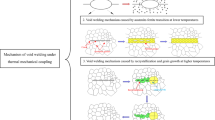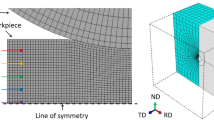Abstract
A theory for determining the critical inclusion size with respect to void formation during hot working operation is presented. The theoretical model assumes that the relationship between inclusion size (r) and number (n) is of the typen = 1/rα. Equations are deduced for the three cases α = 2,α = 3 and α = 4. The most reliable results are obtained if α equals 3 or 4. The critical inclusion size is of the order of 2.5 to 3.5 μm for strains of about 0.7.
Similar content being viewed by others
References
R. Kiessling and H. Nordberg:Conference on Production and application of clean steel, held in Balatonfiired, Hungary, June 23–26, 1970, pp. 179–85. Iron and Steel Institute, London, 1970.
S. Rudnik:J. Iron Steel Inst., 1966, vol. 204, pp. 374–76.
T. J. Baker and J. A. Charles:J. Iron Steel Inst., 1972, vol. 210, pp. 680–90.
E. Rozovsky, W. Hahn, and B. Avitzur:Met. Trans., 1973, vol. 4, pp. 927–30.
S. Bergh:Jemkontorets Annaler, 1962, vol. 146, pp. 748–62.
S. Ekerot:Scand. J. of Met., 1974, vol. 4, pp. 21–27.
Author information
Authors and Affiliations
Additional information
Formerly with the Department of Ferrous Metallurgy, Royal Institute of Technology, Stockholm.
Rights and permissions
About this article
Cite this article
Klevebring, BI., Bogren, E. & Mahrs, R. Determination of the critical inclusion size with respect to void formation during hot working. Metall Trans A 6, 319 (1975). https://doi.org/10.1007/BF02667285
Received:
DOI: https://doi.org/10.1007/BF02667285




